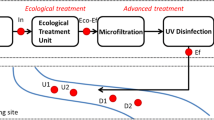Abstract
A decontamination technique based in cyclodextrin extraction has been developed to eliminate nonylphenol (NP) and 16 polycyclic aromatic hydrocarbons (PAHs; the US Environmental Protection Agency priority pollutants list) from sewage sludge. In a first step, PAHs and NP were characterised in six sludges to determine contamination levels according to limit values proposed by the European Union Sludge Directive draft. There were few variations in the total PAHs content with levels of 1.88 to 3.05 mg kg−1. Three-ring PAHs predominated, but fluoranthene and pyrene were also present. None of the sludge exceeded the PAHs limit proposed by the European Union’s draft Directive. On the contrary, NP content in four of the six sludges was over the recommended limits of 50 mg kg-1 for NP ethoxylates. With the aim of obtaining NP values below the concentration limits proposed to use the sewage sludge as agricultural amendments, a preliminary study using hydroxypropyl-β-cyclodextrin (HPBCD) extractions as a decontamination technique was carried out. About 90 % of NP content was removed with only one extraction with HPBCD, whereas after three sequential extractions using an aqueous solution without HPBCD, the NP extraction percentage was less than 1 %. Simultaneously, PAHs extraction percentages obtained with HPBCD were also much higher than when aqueous solution was used, especially in the case of two- and three-ring PAHs. Finally, the potential environmental hazard of HPBCD leachates to aquatic organisms (Daphnia magna) was tested. These results indicate that the treatment of sewage sludge with cyclodextrin could allow their safe use as fertiliser in agriculture.



Similar content being viewed by others
References
Abad E, Martínez K, Planas C, Palacios O, Caixach J, Rivera J (2005) Priority organic pollutant assessment of sludges for agricultural purposes. Chemosphere 51:1358–1369
Alexander M (2000) Aging, bioavailability, and overestimation of risk from environmental pollutants. Environ Sci Technol 34:4259–4265
Aparicio I, Santos JL, Alonso E (2009) Limitation of the concentration of organic pollutants in sewage sludge for agricultural purposes: a case study in South Spain. Waste Manag 29:1747–1753
ASTM (1999) Standard methods for measuring the toxicity of sediment-associated contaminants with freshwater invertebrates. E 1706-95b. In: Annual book of ASTM standards. ASTM, Philadelphia, pp. 65–68
Badr T, Hanna K, de Brauer C (2004) Enhanced solubilization and removal of naphthalene and phenanthrene by cyclodextrins from two contaminated soils. J Hazard Mat B112:215–223
Barata C, Alañón P, Gutierrez-Alonso S, Riva MC, Fernández C, Tarazona JV (2008) A Daphnia magna feeding bioassay as a cost effective and ecological relevant sublethal toxicity test for environmental risk assessment of toxic effluents. Sci Tot Environ 405:78–86
Blanchard M, Teil MJ, Ollivon L, Legenti L, Chevreuil M (2004) Polycyclic aromatic hydrocarbons and polychlorobiphenyls in wastewater and sewage sludges from the Paris area (France). Environ Res 95:184–197
Burgess RM, Pelletier MC, Gundersen JL, Perron MM, Ryba SA (2005) Effects of different forms of organic carbon on the partitioning and bioavailability of nonylphenol. Environ Toxicol Chem 24:1609–1617
Campos B, Piña B, Fernández-Sanjuán M, Lacorte S, Barata C (2012) Enhanced offspring production in Daphnia magna clones exposed to serotonin reuptake inhibitors and 4-nonylphenol. Stage- and food-dependent effects. Aquat Toxicol 109:100–110
Céspedes R, Lacorte S, Ginebreda A, Barceló D (2008) Occurrence and fate of alkylphenols and alkylphenol ethoxylates in sewage treatment plants and impact on receiving waters along the Ter River (Catalonia, NE Spain). Environ Pollut 153:384–392
Comber MHI, Williams TD, Stewart KM (1993) The effects of nonylphenol on Daphnia magna. Water Res 27:273–276
Dai JY, Xu MQ, Chen JP, Yang XP, Ke ZS (2007) PCDD/F, PAH and heavy metals in the sewage sludge from six wastewater treatment plants in Beijing, China. Chemosphere 66:353–361
European Union (1986) Council Directive 86/278/ECC: protection of the environment, and in particular of the soil, when sewage sludge is used in agriculture. Official Journal L 181:6–12
European Union (2000) EC working document on sludge, 3rd draft: 27 April 2000. ENV.E.3/LM, European Union, Brussels, Belgium
European Union (2003) Council Directive 2003/53/EC of the European Parliament and the Council of 18 June 2003 amending for the 26th time Council Directive 76/769/EEC relating to restrictions on the marketing and use of certain dangerous substances and preparations (nonylphenol, nonylphenol ethoxylate and cement). Official Journal of the European Union 17.7.2003. L 178/24
Fenyvesi E, Gruiz K, Verstichel S, De Wilde B, Leitgib L, Csabai K, Szaniszlo N (2005) Biodegradation of cyclodextrins in soil. Chemosphere 60:1001–1008
Fenyvesi E, Molnár M, Letigib L, Gruiz K (2009) Cyclodextrin-enhanced soil-remediation technologies. Land Contam Reclam 17:585–597
Fernández-Sanjuán M, Rigol A, Sahuquillo A, Rodríguez-Cruz S, Lacorte S (2009) Determination of alkylphenols and alkylphenol ethoxylates in sewage sludge: effect of simple pre-treatment. Anal Bioanal Chem 394:1525–1533
Ginés JM, Pérez-Martínez JI, Arias MJ, Moyano JR, Morillo E, Ruiz-Conde A, Sánchez-Soto PJ (1996) Inclusión of the herbicide 2,4-dichlorophenoxyacetic acid (2,4-D) with beta-cyclodextrin by different processing methods. Chemosphere 33:321–334
Gómez J, Alcantara MT, Pazos M, Sanromán MA (2010) Soil washing using cyclodextrins and their recovery by application of electrochemical technology. Chem Eng J 159:53–57
Gómez-Rico MF, Font R, Aracil I, Fullana A (2007) Analysis of organic pollutants in sewage sludges from the Valencian Community (Spain). Environ Contam Toxicol 52:306–316
González MM, Martín J, Santos JL, Aparicio I, Alonso E (2010) Occurence and risk assessment of nonylphenol and nonylphenol ethoxylates in sewage sludge from different convencional treatment processes. Sci Total Environ 408:563–570
Gould S, Scott R (2005) 2-Hydroxypropyl-β-cyclodextrin (HP-β-CD): a toxicology review. J Food Chem Toxicol 43:1451–1459
Hajdu C, Gruiz K, Fenyvesi E, Nagy ZM (2011) Application of cyclodextrins in environmental bioassays for soil. J Incl Phenom Macrocycl Chem 70:307–313
Hartnik T, Jensen J, Hermens JLM (2008) Nonexhaustive b-cyclodextrin extraction as a chemical tool to estimate bioavailability of hydrophobic pesticides for earthworms. Environ Sci Technol 42:8419–8425
Ifelebuegu AO (2011) The fate and behavior of selected endocrine disrupting chemicals in full scale wastewater and sludge treatment unit processes. Int J Environ Sci Technol 8:245–254
Kawasaki N, Araki M, Nakamura T, Tanada S (2001) Inclusión behavior of 4-nonylphenol into cyclodextrin derivates. J Colloid Interf Sci 238:215–218
Khadhar S, Higashi T, Hamdi H, Matsuyama S, Charef A (2010) Distribution of 16 EPA-priority polycyclic aromatic hydrocarbons (PAHs) in sludges collected from nine Tunisian wastewater treatment plants. J Hazard Mater 183:98–102
Kiss T, Fenyvwsi F, Pasztor N, Feher P, Varadi J, Kocsan R, Szente L, Fenyvesi E, Szabo G, Vecsernyes M, Bacskay I (2007) Cytotoxicity of different types of methylated β-cyclodextrins and ionic derivatives. Pharmazie 62:557–558
Laturnus F, Arnold K, Gron C (2007) Organic contaminants from sewage sludge applied to agricultural soils. Environ Sci Pollut Res 14:53–60
Lian J, Liu JX, Wei YS (2009) Fate of nonylphenol polyethoxylates and their metabolites in four Beijing wastewater treatment plants. Sci Total Environ 407:4261–4268
Martínez E, Gros M, Lacorte S, Barceló D (2004) Simplified procedures for the análisis of polycyclic aromatic hydrocarbons in water, sediments and mussels. J Chromatogr A 1047:181–188
McAllister L, Semple KT (2010) Measurement of bioaccesibility of organic pollutants in soil. In: S.P. Cummings (ed) Bioremediation, methods in molecular biology, vol. 599. Humana Press, New York, pp. 1–14
Miégle C, Dugay J, Hennion MC (2003) Optimization, validation and comparison of various extraction techniques for the trace determination of polycyclic aromatic hydrocarbons in sewage sludges by liquid chromatography coupled to diode-array and fluorescence detection. J Chromatogr A 995:87–97
Minamiyama M, Ochi S, Suzuki Y (2006) Fate of nonylphenol polyethoxylates and nonylphenoxy acetic acids in an anaerobic digestion process for sewage sludge treatment. Water Sci Technol 53:221–226
Morillo E, Maqueda C, Reinoso R, Undabeytia T (2002) Effect of two organic amendements on norflurazone retention and release by soils of different characteristics. Environ Sci Technol 36:4319–4325
Morillo E, Romero AS, Madrid L, Villaverde J, Maqueda C (2008) Characterization and sources of PAHs and potentially toxic metals in urban environments of Seville (South Spain). Water Air Soil Pollut 187:41–51
Morillo E, Sánchez-Trujillo MA, Moyano JR, Villaverde J, Gómez-Pantoja ME, Pérez-Martínez JI (2012) Enhanced solubilization of six PAHs by three synthetic cyclodextrins for remediation applications. Molecular modeling of the inclusion complexes. Plos ONE. doi:10.1371/journal.pone.0044137
Navarro A, Endo S, Gocht T, Barth JAC, Lacorte S, Barceló D, Grathwohl P (2009) Sorption of alkylphenols on Ebro River sediments: comparing isotherms with field observations in river water and sediments. Environ Pollut 157:698–703
Olah J, Cserhati T, Szejtli J (1998) β-cyclodextrin enhanced biological detoxification of industrial wastewaters. Water Res 22:1345–1351
Oleszczku P (2008) Aplication of hydroxypropyl[β]cyclodextrin to evaluation of polycyclic aromatic hydrocarbon losses during sewage sludges composting. J Environ Sci Health A 43:10–17
Oleszczuk P (2007) Changes of polycyclic aromatic hydrocarbons during composting of sewage sludges with different properties and PAHs content. Chemosphere 67:582–591
Oleszczuk P (2009) Application of three methods used for the evaluation of polycyclic aromatic hydrocarbons (PAHs) bioaccesibility for sewage sludge composting. Bioresource Technol 100:413–420
Olmstead AW, LeBlanc GA (2005) Joint action of polycyclic aromatic hydrocarbons: predictive modeling of sublethal toxicity. Aquat Toxicol 75:253–262
Pérez S, Guillamón M, Barceló D (2001) Quantitative analysis of polycyclic aromatic hydrocarbons in sewage sludge from wastewater treatment plants. J Chromatogr A 938:57–65
Petitgirard A, Djehiche M, Persello J, Fievet P, Fatin-Roge N (2009) PAH contaminated soil remediation by reusing an aqueous solution of cyclodextrins. Chemosphere 75:714–718
Pousada-Ferradas Y, Seoane-Labandeira S, Mora-Gutierrez A, Nunez-Delgado (2012) A risk of water pollution due to ash-sludge mixtures: column trials. Int J Environ Sci Technol 9:21–29
Rhodes AH, McAllister LE, Semple KT (2010) Linking desorption kinetics to phenanthrene biodegradation in soil. Environ Pollut 158:1348–1353
Semple KT, Doick KJ, Wick LY, Harms H (2007) Microbial interactions with organic contaminants in soil: definitions, processes and measurement. Environ Pollut 150:166–176
Shen RY, Luo YM, Zhang GY, Teng Y, Li ZG, Wu LH (2007) Contamination of PAHs in sludge samples from the Yangtze River delta area. Pedosphere 17:373–382
Soares A, Guieysse B, Jefferson B, Cartmell E, Lester JN (2008) Nonylphenol in the environment: a critical review on occurrence, fate, toxicity and treatment in wastewaters. Environ Int 34:1033–1049
Sun H, Gu X (2005) Comprehensive toxicity study of nonylphenol and short-chain nonylphenol polyethoxylates on Daphnia magna. Bull Environ Contam Toxicol 75:677–683
Villar P, Callejón M, Alonso E, Jiménez JC, Guiraúm A (2006) Temporal evolution of polycyclic aromatic hydrocarbons (PAHs) in sludge from wastewater treatment plants, comparison between PAHs and heavy metals. Chemosphere 64:535–541
Villaverde J (2007) Time-dependent sorption of norflurazon in four different soils: use of β-cyclodextrin solutions for remediation of pesticide-contaminated soils. J Hazard Mater 142:184–190
Villaverde J, Pérez-Martínez JI, Maqueda C, Ginés JM, Morillo E (2005a) Inclusión complexes of alpha- and gamma-cyclodextrins and the herbicide norflurazon: I. Preparation and characterization. II. Enhanced solubilisation and removal from soils. Chemosphere 60:656–664
Villaverde J, Maqueda C, Morillo E (2005b) Improvement of the desorption of the herbicide norflurazon from soils via complexation with β-cyclodextrin. J Agric Food Chem 53:5366–5372
Villaverde J, Posada-Baquero R, Rubio-Bellido M, Láiz L, Sáiz-Jimenez C, Sánchez-Trujillo MA, Morillo E (2012) Enhanced mineralisation of diuron using a cyclodextrin-based bioremediation technology. J Agric Food Chem 60:9941–9947
Wacker Chemie (2103) CawasolW7 HPMaterial Safety data Sheet. http://www.wacker.com/cms/en/productsmarkets/products/product.jsp?product=8971
Ying GG (2006) Fate, behavior and effects of surfactants and their degradation products in the environment. Environ Int 32:417–431
Zar JH (1996) Bioestatistical analysis. Bioestatistical analysis. Prentice-Hall, Upper Saddle River
Acknowledgements
Support from projects CTM2006-04626 and CTM2009-07335, Spanish Ministry of Science and Innovation (co-funded by Fondo Europeo de Desarrollo Regional, FEDER), are greatly appreciated. M.A. Sánchez-Trujillo acknowledges a research contract from Consejo Superior de Investigaciones Científicas (CSIC, JAEPre 0800763) cofinanced by Fondo Social Europeo (FSE).
Author information
Authors and Affiliations
Corresponding author
Additional information
Responsible editor: Philippe Garrigues
Rights and permissions
About this article
Cite this article
Sánchez-Trujillo, M.A., Lacorte, S., Villaverde, J. et al. Decontamination of polycyclic aromatic hydrocarbons and nonylphenol from sewage sludge using hydroxypropyl-β-cyclodextrin and evaluation of the toxicity of leachates. Environ Sci Pollut Res 21, 507–517 (2014). https://doi.org/10.1007/s11356-013-1930-4
Received:
Accepted:
Published:
Issue Date:
DOI: https://doi.org/10.1007/s11356-013-1930-4




